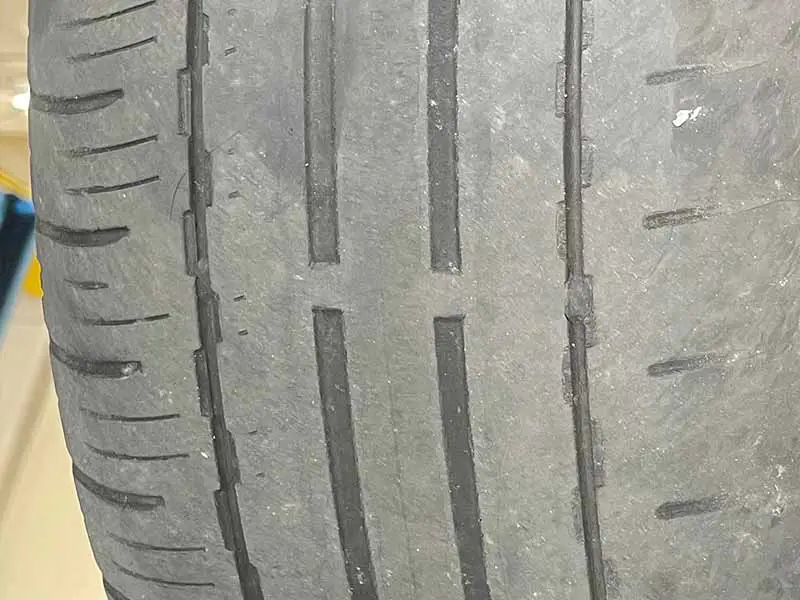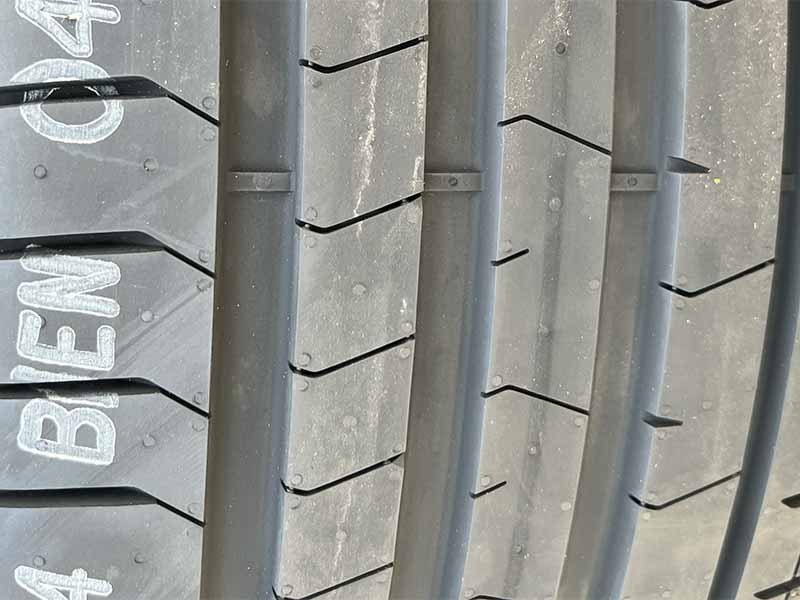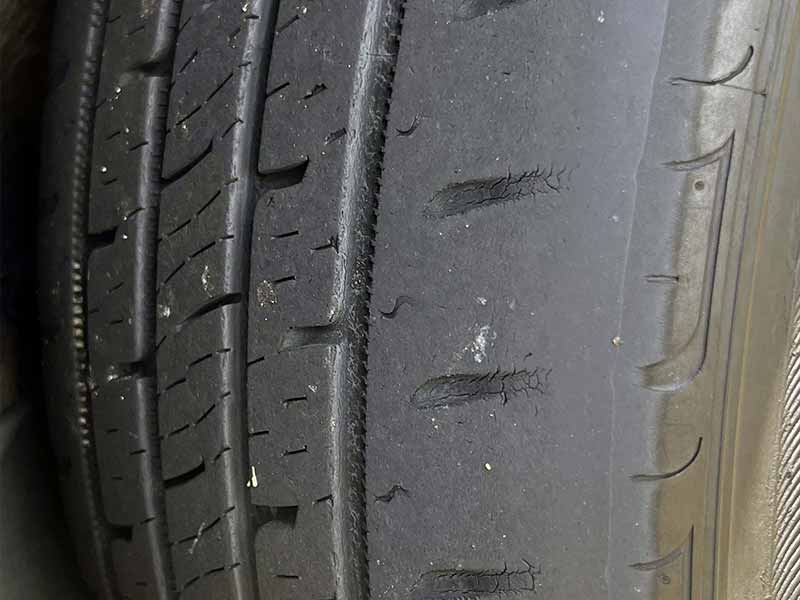The concept of a bald tire seems simple at first, but when you notice a tire with low tread or uneven wear it can make you wonder where exactly the line is between a bald tire and a good tire.
New tires are expensive and most of us don’t want to have to speed a large amount of money on new tires unless we absolutely need to do so.

How to Tell If Your Tires Are Bald
A visual inspection of the wear bars is usually all that is required to tell if your tires are bald. If the top of the tread blocks are above the wear bars, you have enough tread depth to continue using your tires.
Be sure to inspect the wear bars at several points around your tire tread to ensure there is enough tire tread depth around the entire circumference and width of the tire tread.
Even if you have a small bit of life left in those old tires, you may want to consider replacing them. Tire performance drops rapidly as they get close to the minimum acceptable level of tread wear.
Let’s take a closer look.
How Bald Is Too Bald For Tires
The common tire tread depth that is considered bald in most states around the country is 2/32″ of remaining tread rubber. Tires worn to this point or more are too bald because the depth of the grooves in your tire’s tread is too shallow to properly channel water out from underneath the contact patch of the tire.
If only one point on a tire meets this definition the tire is considered bald and should be replaced immediately.
Most tire professionals recommend replacing tires once they’ve reached 4/32″ since they have lost a significant amount of their performance and the majority of the value has been used up.
As tires wear they slowly lose wet traction. As they wear down closer to the minimum amount they begin losing performance more dramatically.
The difference between 10/32″ and 8/32″ of wear is hardly noticeable while the difference between 4/32″ and 2/32″ can be as much as the difference between 4/32″ and new tires.
How To Check Tire Tread
There are multiple methods for determining the current wear level on your tires and whether or not it is still within a safe range.
It’s important to know that when measuring your tire’s tread depth you should do so at multiple points around the tire and across the width of the tread pattern.
Uneven tire wear can cause a bald tire surface on some parts of the tread pattern while others may have a significant amount of tread remaining.
Wear Bars
A wear bar is a raised bar or bump located at several locations around the circumference and across the width of your tire’s tread. Not all tires will feature these indicator bars, however. Although most that don’t will have an alternative wear indicator design.
They can be found at the bottom of the deepest tread grooves and are often in a line or slightly staggered across the width of the tire. They will also usually be found at approximately six points around the circumference of the tire.
2/32″ is the height of the wear bar. New tires will have 10/32″ or 11/32″ of tire tread and as the tires wear down over time, the tread surface comes closer and closer to the height of the wear indicator bars.

Penny Test
The penny test is a convenient alternative to checking your tire’s tread wear level that will give you a little more feedback. It is also helpful to know if you happen to have tires that don’t feature built-in wear indicators or you can’t locate them.
How To Check Tire Tread With A Penny
- Place a penny upside down in the deep tread grooves between tread ribs.
- If all of Lincoln’s head is visible you should replace your tires immediately.
- If all of Lincoln’s forehead is visible, you should consider replacing your tires soon.
- If part of Lincoln’s forehead is obscured by your tire treads, your tread is at an acceptable depth.
Tread Depth Gauge
For precisely measuring your tire’s tread you will want to use a tread depth gauge. These inexpensive tools will allow you to accurately measure the remaining tread depth and determine if you are riding on bald tires, heavily worn tires, or tires with plenty of remaining life.
How To Measure Tread Depth With A Gauge
- Insert the probe of your gauge in one of the main grooves in your tire tread design pattern.
- Push down on the top of the gauge until the shoulders of the gauge come to rest on top of the tread blocks and the probe contacts the bottom of the tread groove.
- Remove the gauge from the top of the tread, being careful to not nudge the probe, to read the measurement.
- Repeat the process at several points around the circumference and width of the tire.
Bald Tires Symptoms
It may not be easy to tell if you have bald tires unless you actually look at them, but there are some symptoms of bald tires that should alert you to a problem:
Traction
The most noticeable symptom of bald tires is reduced traction. Newer tires with good tread can maintain traction at higher speeds and quicker acceleration when it’s wet outside.
If your tread is worn to the point that you have bald tires, they will struggle to maintain grip in wet conditions.
If you notice your traction control light on your dashboard flickering on rainy days, it’s possible your tires need to be replaced.
Stopping Distance
Bald tires make it difficult for your tires to maintain traction and grip the road surface properly. For tire tread to provide traction, it needs to have enough space in the grooves of the tread pattern to channel water away from underneath the tire.
This won’t affect normal braking, but it will affect panic stops when your anti-lock brakes need to kick in to prevent your car or truck from skidding forward.
The difference in distance between panic braking with new tires and bald tires can be doubled. The ABS won’t need to be activated as often or for as long with new tires since they can better maintain grip at higher speeds on wet roads and during heavier rains.
Hydroplaning
Hydroplaning is very similar to hitting a large patch of ice. It is a situation where the speed of your vehicle, combined with the tire’s inability to move water away from underneath your tires, causes your car or truck to glide across a cushion of water without any contact with the pavement.
Your tires may spin. You might attempt to steer but it will have no effect. You may try to brake but nothing will happen. You will have absolutely no vehicle control. It is a very scary situation to find yourself in.
Eventually, you will regain control once you have slowed down enough. The hope is that you regain control before you drift off the road and into a ditch or another vehicle.
Increased Road Noise
Many people that have experienced driving on bald tires have complained of increased road noise. Balding tires have much less rubber to deaden the sound of the tire roar from the rough asphalt or pavement.
Often though, the issue isn’t just road noise but noise caused by uneven tire wear that has caused the tire’s tread to have worn down enough in some areas to have little or no tread left.
Bald Tires Vs Good Tires
Bald tires increase your risk of an accident during wet conditions or on dry roads. Most issues with bald tires happen in rainy weather, but bald tires can be easily punctured due to there being very little rubber to stop a nail or screw from penetrating through to the tire carcass.
Good tread will be evenly worn and have deep enough grooves to keep the treads in contact with the road surface. Handling ability and braking distances will remain within safe amounts.
- Good tread is generally considered to be anything more than 4/32″ of the tread.
- Worn tires are considered to be between 4/32″ and 2/32″ of the tread.
- Bald tires are 2/32″ or less of the tread.
Are Bald Tires Illegal
Tread less than 2/32″ in depth is illegal in most states, but this varies. For instance, Florida allows a minimum depth of 1/32″.
It’s not really practical for the police to drive around writing tickets for every car with a bald tire that they see. But they can ticket and fine you if you’re involved in an accident and find that you have a bald tire.
You can also be found at fault for an accident if you have bald tires. They can certainly be the difference between you being able to stop in time to prevent an accident.
Resources
Below are some links you may find helpful when learning about tires
Final Thoughts
Be sure to rotate your tires regularly and maintain enough air pressure to help them wear evenly and last longer. Proper tire maintenance can help you get many more miles out of that expensive set of tires.
The increased risk of an accident isn’t worth trying to squeeze out a few more miles from some worn or bald tires.
If your tire’s tread is flush with the wear bars you should have them replaced immediately. If they are getting close to the wear bar, you may want to go ahead and buy some new tires for your safety and the safety of others on the road.
Good luck and happy motoring.







